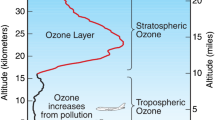Abstract
HAMPSON1 has commented on the possible destruction of the Earth's ozone shield by nitric oxide generated during nuclear explosions in the atmosphere. He suggested that if such an ozone decrease were large enough and lasted long enough, it might have disastrous effects on the biosphere. Here, we assess quantitatively Hampson's suggestion.
Similar content being viewed by others
References
Hampson, J., Nature, 250, 189 (1974).
Foley, H. M., and Ruderman, M. A., J. geophys. Res., 78, 4441 (1973).
Gilmore, F. R., The Production of Nitric Oxides by Low Altitude Nuclear Explosions, J. geophys. Res., (in the press).
Peterson, K. R., Hlth Phys., 18, 357 (1970).
The 1974 World Almanac, 505 (Newspaper Enterprise, 1974).
Morel, P., and Larcheveque, M., J. atmos. Sci., 31, 2189 (1974).
Whitten, R. C., and Turco, R. P., AIAA Journal, 12, 1110 (1974).
Wofsy, S. C., and McElroy, M. B., J. geophys. Res., 78, 2619 (1973).
Wuebbles, D. J. and Chang, J. S., Preprints of the Second International Conference on the Environmental Impact of Aerospace Operations in the High Atmosphere, 136 (American Meteorological Society, 1974).
Author information
Authors and Affiliations
Rights and permissions
About this article
Cite this article
WHITTEN, R., BORUCKI, W. & TURCO, R. Possible ozone depletions following nuclear explosions. Nature 257, 38–39 (1975). https://doi.org/10.1038/257038a0
Received:
Accepted:
Published:
Issue Date:
DOI: https://doi.org/10.1038/257038a0
- Springer Nature Limited





